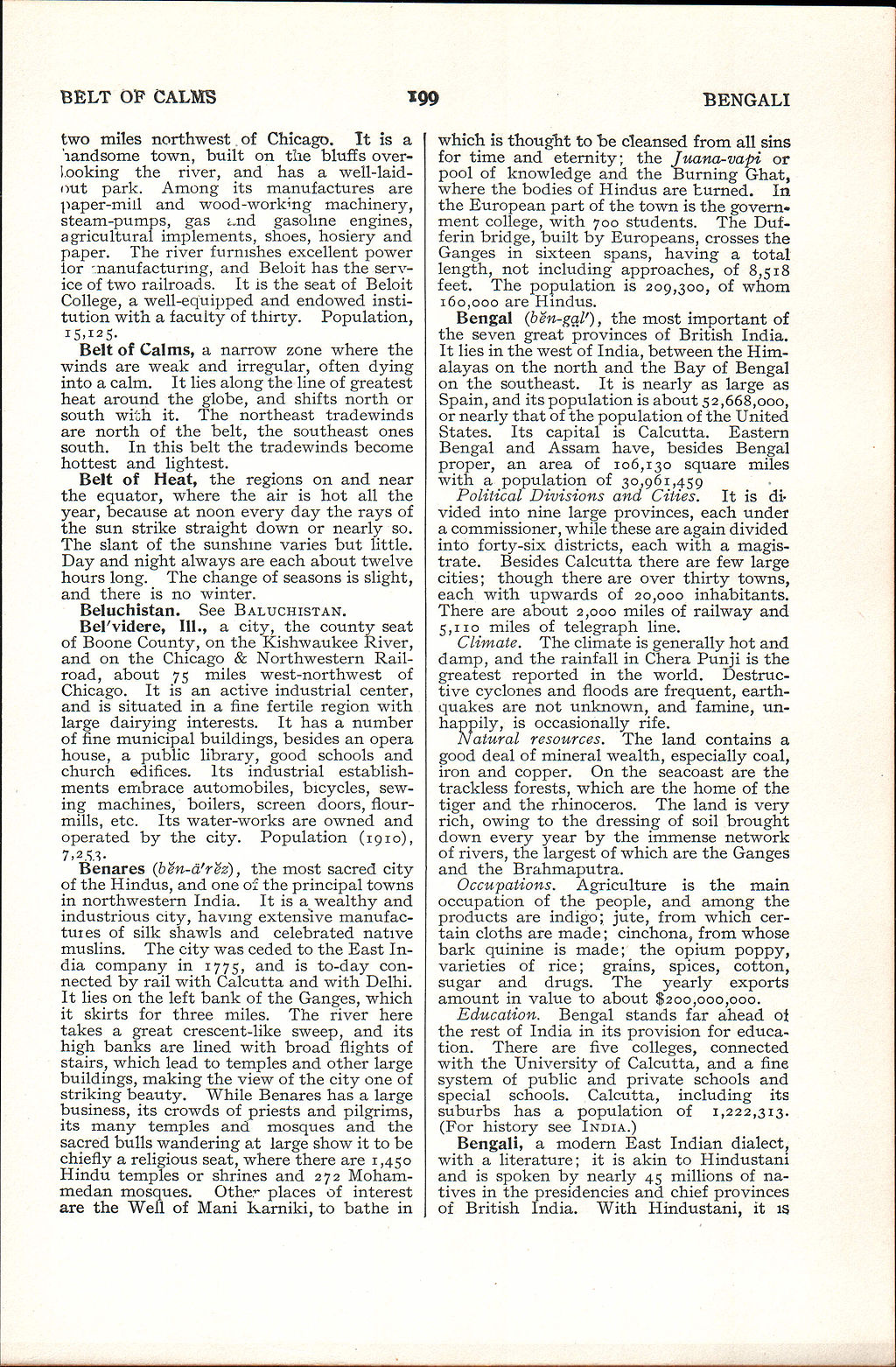BELT OF CALMS
199
BENGALI
two miles northwest of Chicago. It is a
land some town, built on the bluffs over-Looking the river, and has a well-laid-out park. Among its manufactures are paper-mill and wood-working machinery, steam-pumps, gas L,nd gasoline engines, agricultural implements, shoes, hosiery and paper. The river furnishes excellent power tor 'nanufacturmg, and Beloit has the service of two railroads. It is the seat of Beloit College, a well-equipped and endowed institution with a faculty of thirty. Population, 15.125.
Belt of Calms, a narrow zone where the winds are weak and irregular, often dying into a calm. It lies along the line of greatest heat around the globe, and shifts north or south with it. The northeast tradewinds are north of the belt, the southeast ones south. In this belt the tradewinds become hottest and lightest.
Belt of Heat, the regions on and near the equator, where the air is hot all the year, because at noon every day the rays of the sun strike straight down or nearly so. The slant of the sunshine varies but little. Day and night always are each about twelve hours long. The change of seasons is slight, and there is no winter.
Beluchistan. See BALUCHISTAN.
Bel'videre, 111., a city, the county seat of Boone County, on the Kishwaukee River, and on the Chicago & Northwestern Railroad, about 75 miles west-northwest of Chicago. It is an active industrial center, and is situated in a fine fertile region with large dairying interests. It has a number of fine municipal buildings, besides an opera house, a public library, good schools and church edifices. Its industrial establishments embrace automobiles, bicycles, sewing machines, boilers, screen doors, flour-mills, etc. Its water-works are owned and operated by the city. Population (1910),
7,2.tt-
Benares (ben-d'rez), the most sacred city of the Hindus, and one of the principal towns in northwestern India. It is a wealthy and industrious city, having extensive manufac-tuies of silk shawls and celebrated native muslins. The city was ceded to the East India company in 1775, and is to-day connected by rail with Calcutta and with Delhi. It lies on the left bank of the Ganges, which it skirts for three miles. The river here takes a great crescent-like sweep, and its high banks are lined with broad flights of stairs, which lead to temples and other large buildings, making the view of the city one of striking beauty. While Benares has a large business, its crowds of priests and pilgrims, its many temples and mosques and the sacred bulls wandering at large show it to be chiefly a religious seat, where there are 1,450 Hindu temples or shrines and 272 Mohammedan mosques. Other places of interest are the Well of Mani Karniki, to bathe in
which is thouglit to "be cleansed from all sins for time and eternity; the Juana-vapi or pool of knowledge and the Burning Ghat, where the bodies of Hindus are turned. In the European part of the town is the government college, with 700 students. The Duf-ferin bridge, built by Europeans, crosses the Ganges in sixteen spans, having a total length, not including approaches, of 8,518 feet. The population is 209,300, of whom 160,000 are Hindus.
Bengal (ben-gal'), the most important of the seven great provinces of British India. It lies in the west of India, between the Himalayas on the north and the Bay of Bengal on the southeast. It is nearly as large as Spain, and its population is about 52,668,000, or nearly that of the population of the United States. Its capital is Calcutta. Eastern Bengal and Assam have, besides Bengal proper, an area of 106,130 square miles with a population of 30,961,459
Political Divisions ana Cities. It is divided into nine large provinces, each under a commissioner, while these are again divided into forty-six districts, each with a magistrate. Besides Calcutta there are few large cities; though there are over thirty towns, each with upwards of 20,000 inhabitants. There are about 2,000 miles of railway and 5,no miles of telegraph line.
Climate. The climate is generally hot and damp, and the rainfall in Chera Punji is the greatest reported in the world. Destructive cyclones and floods are frequent, earthquakes are not unknown, and famine, unhappily, is occasionally rife.
Natural resources. The land contains a good deal of mineral wealth, especially coal, iron and copper. On the seacoast are the trackless forests, which are the home of the tiger and the rhinoceros. The land is very rich, owing to the dressing of soil brought down every year by the immense network of rivers, the largest of which are the Ganges and the Brahmaputra.
Occupations. Agriculture is the main occupation of the people, and among the products are indigo; jute, from which certain cloths are made; cinchona, from whose bark quinine is made; the opium poppy, varieties of rice; grains, spices, cotton, sugar and drugs. The yearly exports amount in value to about $200,000,000.
Education. Bengal stands far ahead oi the rest of India in its provision for education. There are five colleges, connected with the University of Calcutta, and a fine system of public and private schools and special schools. Calcutta, including its suburbs has a population of 1,222,313. (For history see INDIA.)
Bengali, a modern East Indian dialect, with a literature; it is akin to Hindustani and is spoken by nearly 45 millions of natives in the presidencies and chief provinces of British India. With Hindustani, it is
